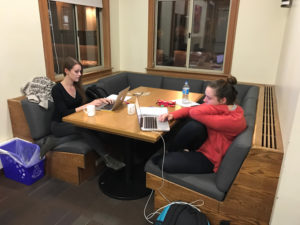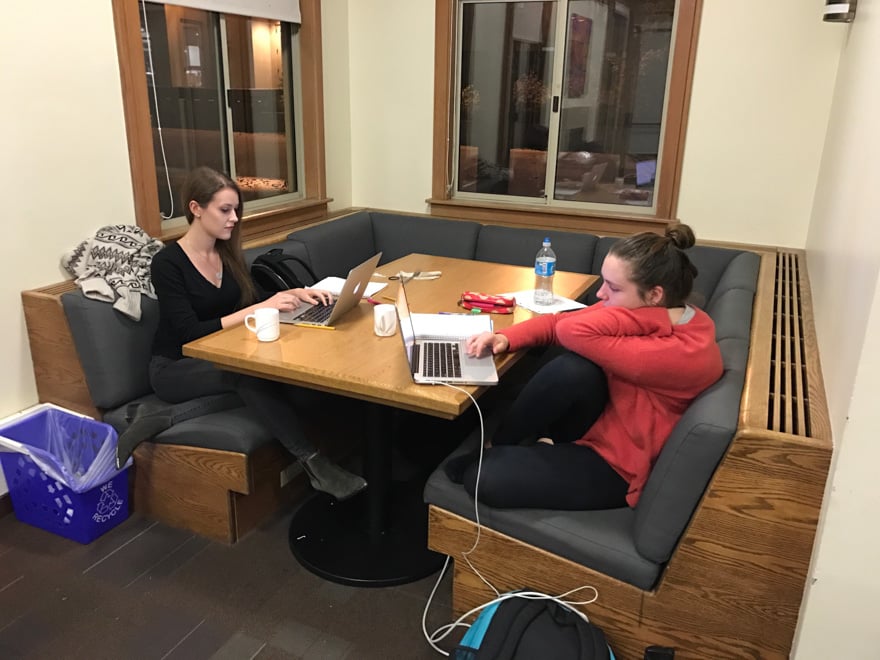This quarter marks the first time since the inception of the Peer Health Educator (PHE) role where multiple resident fellows (RFs) of freshman dorms have refused to hire PHEs. RFs made the decision last spring as a way to boycott the program’s wage system, and many PHEs are still unhappy with their salaries.
Erica Fearon ’18, the PHE in one of Stanford’s new four-class dorms, Norcliffe Hall, loves her job but finds it difficult to justify her wages.
“My frosh, who is a dining hall ambassador, gets paid more than I do,” Fearon said. “He gets paid more than I do, and I do the job of an RA, pretty much, and he just surveys people about whether they like tofu.”
All PHEs on campus are each paid $1,000 by Vaden Health Center for the school year. Their staff counterparts, resident assistants (RAs), receive $10,000 a year from Residential Education and resident computer consultants (RCCs) receive $7,000 from the Office of the Vice Provost for Teaching and Learning.
Despite being paid significantly less, PHEs complete an intense training process. And while RCC training is more technical and computer-focused, RA and PHE training tend to focus on similar concepts.
Prospective PHEs take a four-unit, letter-graded class in the spring, followed by a week of training in the fall before school starts. RAs receive two weeks of fall training and take a two-unit, credit/no-credit course in the spring. PHE training provides students with an in-depth look into all aspects of physical, mental and sexual health they might encounter in their job, from mental disorders to issues of drugs and alcohol.

“We spend in-depth amount of time on each of these things, and the RA class is essentially, like, how to talk to people,” Fearon said. “They don’t do a lot of content.”
Much of PHE training consists of practicing potential scenarios a staff member might encounter, whereas RA training is primarily lecture-based, only practicing counseling scenarios a few times.
According to Alyssa Morrison ’18, the PHE in Soto, the extra training is what really makes a difference.
“I think that having that practical skill base was very useful going in with my co-staff, who felt kind of overwhelmed in staff training,” Morrison said. “When things would come up, they would kind of look to me a lot.”
This year, Cedro, Junipero, Arroyo, Trancos, Twain and Larkin are all without PHEs. Some RFs actively chose not to hire PHEs, while others simply weren’t matched with a PHE during the ranking process.
Lucy and Jason Lee, RFs of Cedro, fell into the latter category last spring. They wanted a PHE, but due to the low pool of applicants, they were unable to take one on. Instead they, and all of the other dorms who did not take PHEs, were able to hire another RA to take the place of the missing staff member.
“The most important thing is to have six trained staff,” Lucy Lee said. “I think that if we were short a staff member, it would have been a burden on our staff.”
So far, Cedro has not experienced any significant differences. Lee attributes this to the fact that one of the dorm’s RAs has taken on many of the responsibilities a PHE would have.
“If we didn’t have the PHE role specifically, we would have to build that into the hiring process for our staff,” Lee said.
While some RFs chose not to hire PHEs because they felt the pay gap was too unfair to look past, the Lees wrestled with the issue.
“We were very conflicted about the whole ‘boycotting the PHE’ idea because, yes, there’s a pay discrepancy, but part of us also thought that the people who applied knew that going in,” Lee said. “We wouldn’t want to just boycott that role if that’s something that they wanted to do. What we really wanted to do was make that more equitable in some way.”
With fewer PHEs on campus this year, Fearon worries that certain dorms are missing out on the level of experience PHE training brings to a dorm staff.
“Going forward, if the RA training absorbs more of the health-related stuff that the PHE training does, it might make sense to simply, instead of having PHEs, just have very health-oriented RAs,” Fearon said. “But right now, I don’t think the RA training is there yet, which is why PHEs are important.”
Despite the PHE pay, most students who apply for the position do so because they believe in its importance. Morrison admitted she sometimes forgets she even gets paid at all.
“Going into it, [the pay] wasn’t really a factor in my decision,” Morrison said. “I was thinking, ‘Oh I want to be invested in my community.’ Nowhere in there was I like, ‘This is the job that I’m going to use to support myself financially during the year.’ My mentality hasn’t been viewing it as that job type and more just like a role that I’ve taken on.”
While PHEs like Morrison and Fearon specifically chose to pursue PHE jobs and not RA jobs, they admit that because the positions are similar enough, the pay gap leaves little incentive for prospective staff members to choose to be a PHE over an RA.
Further, many PHEs speculate that the gender imbalance among students holding the position is encouraged by the pay gap.
“It’s very emotional and touchy-feely, and we value that, whereas men in our society are taught not to value touchy-feely stuff,” Fearon said. “To add on to that, the fact that they’re not going to get paid as much, they’re like, ‘Well, I’m not going to do this.’”
The only one male PHE staffing this year is Kayland Harrison ’17 of Roble.
“Truth be told, it was funny for a minute when people were like, ‘Kayland, you’re the only male PHE.’ I thought, ‘Oh that’s cool,’ and then I thought, ‘Oh, whatever,’” Harrison said. “Honestly, I hope that I’m a good PHE. I don’t think male or female makes a difference.”
Fearon noted that because of the gender breakdown of PHEs, the campus program is starting a kind of gender-based wage gap.
“If PHEs got paid more, we would probably attract a more diverse crowd, including more men. But the pay discrepancy also enforces a weird gender wage gap on this campus where the PHEs are primarily women and the women choose to get paid less because we see this job as something that we value,” she said. “No one intended to have this gap of diversity in the PHE program, but they’re inadvertently causing it by not paying attention.”
One place where this gender gap is made especially clear is in the difference between the staffs in sororities and fraternities. All three housed sororities have PHEs, whereas none of the fraternities do.
Shankara Anand ’17, the RA in Phi Kappa Psi, believes that the lack of fraternity PHEs is an institutional issue, one he is eager to see fixed.
“In my opinion, I think [that] in any fraternity it would be a blessing to have a PHE,” Anand said. “It’s really sad that we don’t, because, really, given a lot of the situations that you come across, especially in a fraternity and any house on this campus, PHE training is very, very relevant. It’s actually come up in our house before, and it’s pretty unanimous that we think having a PHE or having somebody with that training would be great.”
Anand, a former Otero RA, feels strongly about having a PHE, but says that those feelings come more from having previously worked with one.
“I think for a lot of fraternities, it just hasn’t really come up. A lot of fraternities aren’t sitting there saying, ‘Man, we really need to fill this niche,’” he said.
Fraternities on campus follow traditional row house staff structures, which include RAs, RCCs, community managers (CMs), kitchen managers (KMs) and financial managers (FMs). There currently is no precedented process for hiring a PHE at fraternity houses.
“It’s such a key population to reach,” Fearon said, “especially around issues of sexual assault and drinking that the University has been dealing with this fall, and a great way to do that in-house would be requiring frat PHEs.”
Contact Emma Fiander at efiander ‘at’ stanford.edu.
